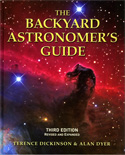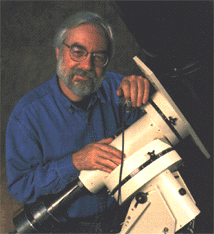Index of Books We Recommend
![]() Pricing
Pricing

"The Backyard Astronomer's Guide" by Terrence Dickinson & Alan Dyer
Hardcover - 368 pages, 3rd Edition - Revised And Expanded, 2008
Firefly Books Ltd.; ISBN: 1-55209-507X
Dimensions (in inches): 11-1/4 x 9-1/2 x 1-3/8
Other Available Editions: None
|
"The Backyard Astronomer's Guide" is our most comprehensive and up to date introductory observational astronomy book. Company Seven recommends this book to those who are thinking about buying an astronomical telescope or binocular, and we suggest it to our customers who have decided to buy first decent instrument. So this is a book that is helpful to read before you buy, and it is a title which after the acquisition will help you to progress over the first year or two into the hobby. The Backyard Astronomer's Guide is beautifully illustrated and it is well written in such a manner that readers from the mid to upper elementary school level all the way up to the experienced adult amateur astronomer will find the book enjoyable, comprehensible, interesting, and informative. And yet a professional astronomer too can enjoy this book without feeling as though they are reading a 'Dick and Jane' story. This edition is an updating of the prior editions to reflect new equipment and techniques. If it were not so well done and comprehensive then the readers could save the fifty bucks and find most of this information on the Internet for free. But this book is worth it: the content is beautifully supported with several hundred color illustrations, several breath taking astrophotographs (for the most part taken by amateur astronomers - a number of whom are customers of Company Seven!), charts and and drawings.
The Backyard Astronomer's Guide is now up to a 4 lb. 5 oz heft, and it is only available in a conventionally bound hardback edition. The black glossy printed areas are so black and so glossy that one should wear clean gloves when turning pages to avoid fingerprinting every other page. This edition is printed on acid-free paper to better insure longevity! These factors suggest it's best use will be as a reference book, to be studied in advance of or after an observing session. For those who seek to learn the night sky Company Seven recommends starting off with a good planisphere and the spiral bound Nightwatch (also by Terrence Dickinson) with a red flashlight to be able to read them at night without adversely affecting one's night vision. This book introduces the reader to the hobby by providing an overview of the night sky and explaining how much can be done with the naked eye alone; this orientation explains why the sky appears to move as the Earth rotate. There is a discussion about sky 'seeing' conditions and how steadiness and transparency (haze or sky glow light pollution from city lights) affects the locating and viewing of some celestial objects. There is some discussion of what may be observed even from an urban setting. An explanation of binoculars follows, explaining what can be seen with them, and then it moves on to introduce the reader to telescopes. This book not only contains much practical advice about how to choose and use binoculars and telescopes for astronomy, but also what to avoid, and where to buy. The content explains telescope assembly and set up including pole alignment, and the use of mechanical setting circles. The instructions are accompanied by well thought out illustrations that help to reinforce the concepts being taught. Discussions towards the end of the book address common issues of telescope maintenance and collimation (alignment of the optics), and telescope testing (since not all consumer telescopes are created equal). There are discussions about specific manufacturers telescopes and accessories (it 'names names') that can be found on the market today. The discussion continues into the selection of accessories and explaining the differences between eyepieces and filters; an amateur can begin to comprehend why one might spend as much for one eyepiece as for a telescope! The Backyard Astronomer's Guide reinforces much about what Company Seven has been teaching to it's customers for decades and we view this as another endorsement of Company Seven's choices of manufacturers pointing out how good so many of the lines we offer are including: Astro-Physics, Orion, Questar, TeleVue, William Optics, and others. Or, more accurately this book can be considered a reflection what Company Seven has espoused for years before the first the first edition of "The Backyard Guide" was published. Part 2 of the book goes into descriptions of celestial objects, with good details about how best and when to observe these objects and phenomena: the Moon, Planets, Sun, Comets, Meteors, Eclipses, even Iridium Flares. And there are tables of information to guide the reader to see celestial phenomena that will occur from 2008 until 2020. The chapter "Milky Way Atlas" is a nicely conceived guide consisting of full pages of wide area color illustrations faced by a chart negative view (white background with the Milky Way appearing as grayish-black clouds) describing what is in the image including: Constellations, major Stars, IC, NGC, Messier objects. However beautiful the printing on the charts is small enough that many adults will need to use a magnifying glass to read, this small print and the background tone relegate this to home use in a well lit environment. Part 3 of this revision includes discussions of technologies (digital camera uses for astrophotography) that were not even contemplated when the original work was published. There is a bibliography of helpful publications and computer software. This book is great, but there are some topics covered where we will agree to disagree with the authors. There are some other things simply missed in this book, and their absence is difficult for us to comprehend. For example the authors completely overlook - do not even mention Fujinon, a company that has contributed several amazing 50mm to 150mm binoculars with a good complement of accessories for astronomy and that in some technical aspects have have yet to be equaled! The Fujinon 70 mm FMT-SX are considered the 'poster child' of great astronomy binoculars and one was selected by author Phil Harrington to grace the cover of his book Touring The Universe Through Binoculars which we also stock. One can't argue the authors are focusing only on the cheaper product since their discussions include some pricey products including Leica binoculars. Some issues are simply a matter of personal preference. The authors endorse the Canon electronic battery powered stabilized binoculars, while dismissing the use of parallelogram stands that can support these and other even larger and better binoculars. Company Seven does offer parallelogram stands designed for use either while standing or reclining, and while these are not for everyone those who have them love them. The authors contradict themselves: they bend their necks to look up through hand held binoculars, yet they write how it is uncomfortable to bend their necks to look up to observe with a well supported better quality image at their eyes. On some subjects we might have written about then differently. For example they mention Vibration Dampeners as being "Not Essential" implying all observers can operate on solid ground. In our experience this accessory can be quite helpful to those who operate a telescope on a resonating rooftop or wood deck. The authors give proper credit to contributors, and they are helpful to readers when they point out the make and model of telescopes or accessories appearing in most images. But rather conspicuously omitted are the credits of a telescope that appears in numerous illustrations and in various configurations - the superb Astro-Physics 92mm f7 'Stowaway' telescope. On some matters we take exception to some comments in the book. For example the authors comment about the recent state of quality control suggesting things are pretty good in the industry. We say things are better than they were a few years ago, but for the public the customer service from most retailers and many manufacturers is about as poor as we have ever seen. The decline in customer service is largely attributable to cost cutting and the shifting of production to overseas. To protect our customers Company Seven unpacks and tests every new binocular or telescope that arrives here, and so we are in a good position to measure quality control of our suppliers. But most of the above nit-picking. These authors sell books and not telescopes, yet on the whole The Backyard Astronomer's Guide is leagues ahead of other titles that aspire to inform amateur astronomers about these subjects.
|
|
Contents
Foreward: by Robert Burnham
Introduction 2. Binoculars for the Beginner and Serious Observer 3. Telescopes for Recreational Astronomy 4. Essential Accessories: Eyepieces and Filters 5. The Backyard Guide 'Accessory Catalog' 6. Using your New Telescope
7. The Naked Eye Sky 8. Observing Conditions: Your Site and Light Pollution 9. Observing the Moon, Sun and Comets 10. Observing the Planets 11. Finding Your Way Around the Sky 12. Exploring the Deep Sky |
13. Digital Astrophotography 14. High-Tech Astronomy 15. Polar Alignment, Collimation and Cleaning The Milky Way Atlas by Glenn LeDrew
Epilogue |
|
Price $49.95 (U.S.D.); this is a heavy book so please add $10.00 for domestic postage, or $20.00 for international postage.
The Authors:
Terrence Dickinson: a leading astronomy writer is the author of fourteen books. He has received numerous national and international awards for his work, among them the New York Academy of Sciences book of the year award and the Astronomical Society of the Pacific's Klumpke-Roberts Award for outstanding contributions in communicating astronomy to the public. In 1994, asteroid 5272 Dickinson was named after him. In 1995, he received the Order of Canada, the nation's highest civilian achievement award. A former editor of Astronomy magazine, Dickinson was an instructor at several science museums and planetariums in Canada and in the United States before turning to science writing full time in 1976. His articles have appeared in many magazines, and he writes a weekly astronomy column for The Toronto Star and a consultant for the Canadian Discovery Channel. He also teaches astronomy part-time at St. Lawrence College, Kingston, Ontario. Dickinson traces his interest in astronomy back to the age of 5, when he was fascinated by the sight of a bright meteor. At 14, he received a good quality 60mm refractor telescope as a Christmas present and since then has owned more than 20 different telescopes. Today, he observes under sixth magnitude night skies, and enjoys astrophotography (having taken most of the pictures in his "Nightwatch" book from his backyard). He lives near the village of Yarker, in rural eastern Ontario where he enjoys dark night skies above his backyard roll off roof observatory crammed with telescopes and astrocameras. Terrence is most familiar to amateur astronomers for his books including:
Alan Dyer a writer/producer of science shows for the planetarium theater at the Alberta Science Centre in Calgary. A former associate editor of Astronomymagazine, Dyer is widely recognized as an authority on consumer telescopes, and his evaluations of equipment, and consumer buyers guides have appeared regularly in Astronomy. He is an experienced astrophotographer, and a frequent speaker at star parties and astronomy conferences. His planetarium programs have played in theaters throughout North America. Dyer recalls, as a child asking his parents permission to stay up late to watch the stars. At 15, using money earned he purchased his first telescope. He has since owned examples of many telescopes on the market. he now prefers high quality optics of moderate size that he can use at a moments notice from his rural home in the big sky country of southern Alberta. |
Contents Copyright 1994-2008 Company Seven All Rights Reserved



 Terrence Dickinson with one of our
Terrence Dickinson with one of our